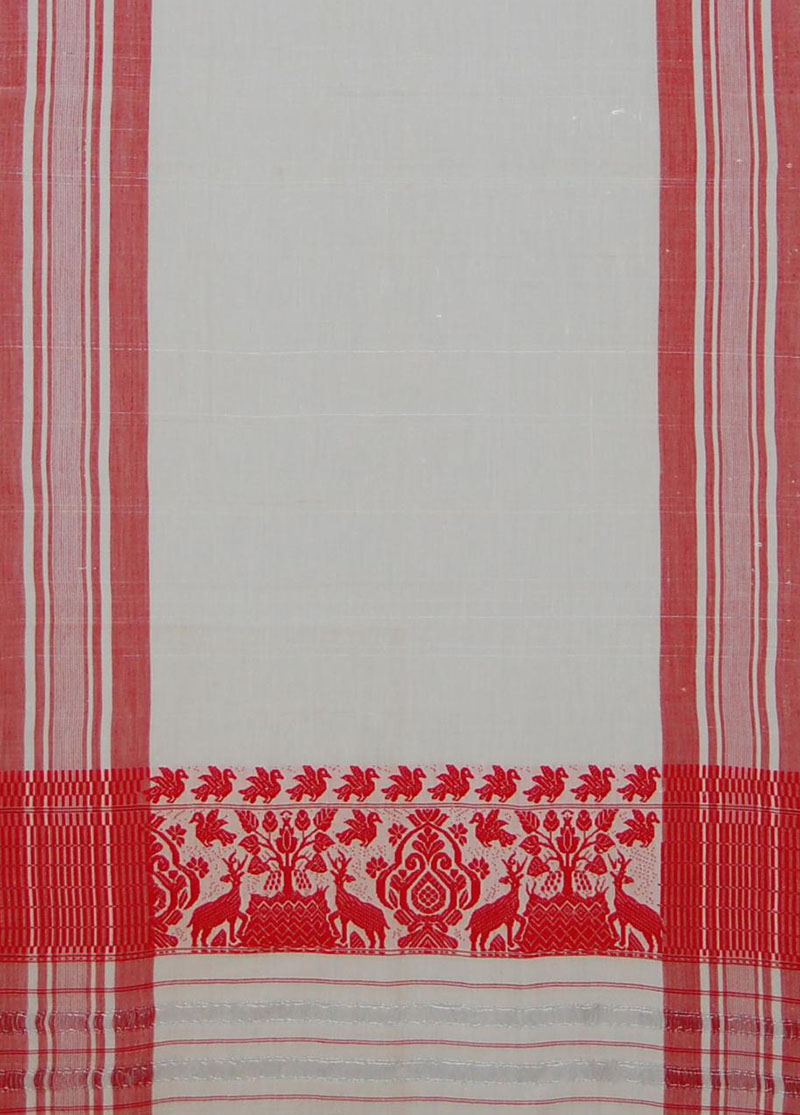A rectangular, handwoven piece of cotton fabric also known as gamucha, gamcha or gamocha, the gamusa is a culturally significant cloth from Assam. The name gamusa comes from the Assamese words ga, meaning “body,” and musa, meaning to “wipe,” though the gamusa itself has several functions beyond being used as a towel. Approximately 122 x 61 cm in size, a traditional gamusa is woven from white cotton, and occasionally pat silk (or mulberry) and features naturalistic or geometric motifs in red along three of its sides. Other accounts ascribe the origins of the word to the Kamrupi word gaamasa, which refers to the cloth used to cover the Bhagavata Purana in a place of worship (yet another use of the modern day gamusa).
Scholars are divided on the geographical origins of the gamusa. While some believe that it originated from within Assam and was popularised by the Ahom people, an ethnic group of Northeast India, others believe that its origins may lie in Thailand, where a similar, smaller cloth is found.
Broadly, the gamusa can be divided into two categories. The first is the uka, or the plain gamusa, which are used as an everyday cloth. An example of this is the pani gamusa, which is coarser in texture and used by agricultural workers to wipe down their bodies. The second category of gamusa is the phulam, which comprises those decorated with floral motifs and used during formal occasions or festivals. This includes the tamul gamusa, the bihuwan and the anakata gamusa to name a few. The tamul is the cloth on which betel nut is traditionally served to visitors in a household, and it is also used to cover the holy scriptures in a prayer hall. The bihuwaan is a formal gamusa gifted to guests for Bihu and, lastly, the anakata is another formal gamusa gifted during special events such as a marriage or a birthday. During Bihu, it is also worn around the waist by male dancers, and is used to cover the instruments played during the festival, such as the dhol and the khol.
In 2019, the gamusa was recognised with a Geographical Indication (GI) tag. The nine types of gamusa included under it are: uka gamosa, phulam gamosa, bihuwan, tioni gamosa, pani gamosa, anakota gamosa, telos gamosa, jor gamosa and xadharon gamosa.






![The façade of the Maneckji Seth Agiary, a Zoroastrian fire temple, is a standout example of the popularity of the Persian Revival Style in Western India in the 19th and 20th centuries. This style was often seen in the architectural patronage of the Parsis, who emerged as one of the most influential mercantile communities of British India. Popular motifs of this style, like the mythical lamasus (winged bulls with human heads) and the faravahar (a winged guardian spirit in Zoroastrianism), drew on the historical art and architecture of the Achaemenid and Sasanian empires from sites like Persepolis, Bisotun, Taq-e Bostan, Naqsh-e Rostam and Naqsh-e Rajab in Persia.
The Parsi community’s adoption of this style occurred largely due to their networks of global commerce and politics, allowing them to access and translate research of ancient Persia into visible symbols that underlined their association with antiquity, imperial power, and art.
نمای آتشکدهی زرتشتی مانِکجی سِت نمونهی بارزی از رواج سبک «احیای [معماری] ایرانی» در غرب هند طی سدههای نوزدهم و بیستم است. این سبک غالباً در بناهایی دیده میشد که پارسیان، از بانفوذترین جوامع بازرگان در هند بریتانیا، بانیشان بودند. نقشمایههای محبوب این سبک، مانند گاو بالدار اساطیری (لاماسو) و فَروَهَر (روح بالدار نگهبان در دین زرتشت)، برگرفته از هنر و معماری شاهنشاهی هخامنشی و ساسانی، در جاهایی چون تخت جمشید و بیستون و طاق بستان و نقش رستم و نقش رجب، بود.
اقتباس جامعهی پارسیان از این سبک بسیار مرهون روابط گستردهی تجاری و سیاسی آنها بود که دسترس به پژوهشها دربارهی ایران باستان و برگردانیدن آنها به نمادهای بصری را ممکن میکرد و بر پیوند پارسیان با دوران باستان و قدرت شاهنشاهی و هنر تأکید میکرد.](https://mapacademy.io/wp-content/plugins/instagram-feed/img/placeholder.png)
